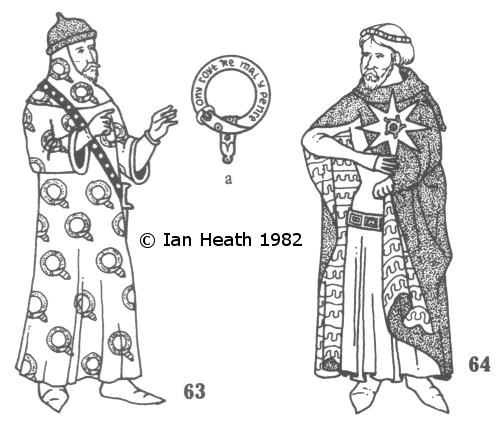|
|
KNIGHTS OF SECULAR ORDERS OF CHIVALRY
An extract from Armies of the Middle Ages, volume 1
by Ian Heath

63 & 64. KNIGHTS OF SECULAR ORDERS OF CHIVALRY
Chivalric Orders abounded in the 14th and 15th centuries.
They were both nationalist and personal to the king or prince responsible for their foundation, and to his heirs,
and generally had a strong religious vein, epitomised by devotion, honour and the protection of noble ladies.
Such brotherhoods also existed in order to wage bitter war, and certainly some late-14th century Orders such as the Golden Apple
(Auvergnese and Bourbonnais knights) and the Poitevin 'Tiercelet'
were established with such practicalities as the sharing of booty or contributing to fellow-members' ransoms very much in mind.
The figures depicted here are representative of 2 of the earliest Orders, those of the Garter and the Star.
63, taken from a source of c.1364, depicts Sir Nigel Loring in the habit of the Order of the Garter,
comprised of a red cap and a fur-lined and trimmed white blanket of monastic cut, with a hood, both powdered with garter devices (which we know from other sources to have been dark blue with gold buckle and pendant and the Order's motto of 'Hony soit qui mal y pense' embroidered in silk and gold; see 63a).
Each suit comprised about 50 such garters.
Oddly enough the Wardrobe Accounts indicate that most suits were in fact blue,
not white, and the very earliest reference to the habit of the Order describes chlamys, supertunic, tunic and hood as all being of blue longcloth 'powdered with garters'.
64 dates to 1370, by which time the Order of the Star no longer actually existed and styles of dress had changed.
Nevertheless the habit depicted - red miniver-lined mantle over white tunic, with a star-shaped badge and a gold belt and circlet -
tallies closely with the Order's habit as described on its foundation in 1351: 'a white tunic, a vermilion supertunic (sercote)
and a hood, when he appears without a mantle.
(The mantle) shall be vermilion lined with miniver ... and beneath this mantle shall be worn a white sercote or a white cote hardie, black hose, and gilded shoes'.
The star is described as 'a flat enamel plate, on it a white star and in the centre of the star a blue roundel, in the middle of the roundel a tiny gold sun'.
This was also worn in battle, being affixed to the surcoat, camail or other armour where it could be clearly seen.
Its size in the illustration is undoubtedly exaggerated.
Of the other early Orders, the Castilian Order of the Sash wore white surcoats with a vermilion sash worn diagonally across the body from the left shoulder.
The habit of the Cypriot Order of the Sword, however, is unknown,
though we know its badge was a silver sword with a cross-shaped hilt and a ribbon bearing the Order's motto ('Cest pour loiautÚ maintenir') wound round it.
Interestingly many Orders in fact only wore a badge, rather more as an indication of personal alliance than to denote membership of an Order,
rather in the way that Lancastrian SS and Yorkist 'sunburst' livery collars were worn in 15th century England.
Examples are Bourbon's Order of the Prisoner's Chain and Foix's Order of the Dragon.
See Appendix 4 for brief details of these and other Orders.
[63. Based on Sir Nigel Loring, Order of the Garter, c.1380, in Liber vite of St Alban's Abbey, Cotton MS Nero D VII, f.105v]
[64. Based on Foundation & Feast of the Order of the Star, in Grandes Chroniques de France de Charles V BnF MS Franšais 2813, France, c.1375-1380]
|

